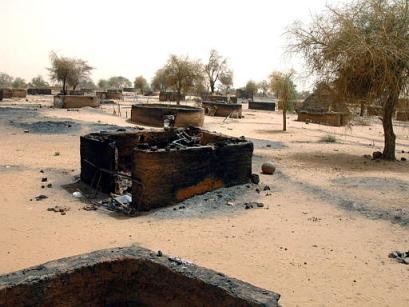Sudanese government is waging a bloody campaign of “ethnic cleansing” in Darfur

By NIKO PRICE, Associated Press Writer
(Updates an item published at 0001 GMT with Sudan minister saying there is no ethnic cleansing in Darfur.)
CAIRO, May 7, 2004 (AP) — Sudan is waging a bloody campaign of “ethnic cleansing” in the western Darfur region, killing thousands of people and driving more than 1 million more from their homes by bombing villages, shooting men and raping women, a prominent human rights group said Friday.
The New York-based Human Rights Watch described a pattern of violence by government forces and militiamen, known as janjaweed, made up of nomads who often sweep into villages riding camels and horses.
Human rights groups said the two forces – the Arab-dominated government and the Arab militia – set out last year on a deliberate campaign to drive black African tribes from the Darfur region.
Sudanese Foreign Minister Mustafa Osman Ismail denied Friday there was any “ethnic cleansing” in Darfur.
“What is happening in Darfur is neither ethnic cleansing nor genocide,” Ismail told the official Sudan News Agency. “It is a state of war, which resulted in a humanitarian situation.”
Ismail was speaking in Khartoum on his return from Kenya. He didn’t mention the Human Rights Watch report.
The rights group called on the U.N. Security Council, scheduled to meet Friday on the Darfur situation, to step in to help stop the bloodshed and look for evidence of crimes against humanity.
It likened the situation in Darfur to the beginning of the 1994 genocide in Rwanda, when 500,000 people were slaughtered by a government-backed, extremist militia. The international community has been widely criticized for not intervening to stop the bloodshed.
“Ten years after the Rwandan genocide and despite years of soul-searching, the response of the international community to the events in Sudan has been nothing short of shameful,” Human Rights Watch said in its 77-page report.
The report drew on a visit to the region by researchers in March and April.
“Together, the government and Arab janjaweed militias targeted the Fur, Masalit and Zaghawa (ethnic groups) through a combination of indiscriminate and deliberate aerial bombardment, denial of access to humanitarian assistance, and scorched-earth tactics that displaced hundreds of thousands of civilians,” the group said.
Sudan ‘s government has denied supporting the janjaweed militia, which it said is defending itself against autonomy-seeking rebels. Ahmed al-Mufti, the head of Sudan ‘s government human rights organization in Khartoum, said Thursday he wouldn’t comment on the Human Rights Watch report.
But Human Rights Watch said the government not only supports the janjaweed – providing salaries, ammunition and satellite telephones – it actually created it.
“They organized them and built them up to what they are today,” said Jemera Rome, a Sudan researcher for Human Rights Watch reached by telephone in London. “The janjaweed have offices in the capitals of the three states of Darfur.”
In its report, Human Rights Watch added: “Janjaweed always outnumber government soldiers, but arrive with them and leave with them. It is not clear which force is the commanding force. It is clear that the Janjaweed are not restrained, in any way, by the uniformed government forces who accompany them in army cars and trucks.”
The report chronicled attacks on 14 villages in one area between September and February that it said killed 770 civilians, although it presented the attacks as examples, saying many more occurred in the same period. All involved coordinated assaults by the government and janjaweed.
It described men on horseback killing 82 men, women and children in a mosque; a militiaman using racial slurs to insult a 3-year-old boy, then shooting him point-blank; and janjaweed raping a group of 13 women.
The violence has sent more than 1 million people fleeing, according to the U.N., and about 110,000 have crossed the border into Chad, although it is difficult to know the exact number.
“People are scattered along this massive strip 370 miles long. It’s a race against time to move them before the rains set in,” in about 10 days, said Peter Kessler, spokesman for the U.N. refugee agency, speaking in a telephone interview from Geneva.
After that, he said, “it will be impossible to get aid to them.”
The Darfur crisis comes as Sudan moves closer to a delicate, internationally brokered peace in a 21-year civil war that broadly pits the Muslim north against the Christian and animist south. More than 2 million people have died in the war. Darfur is almost completely Muslim.
